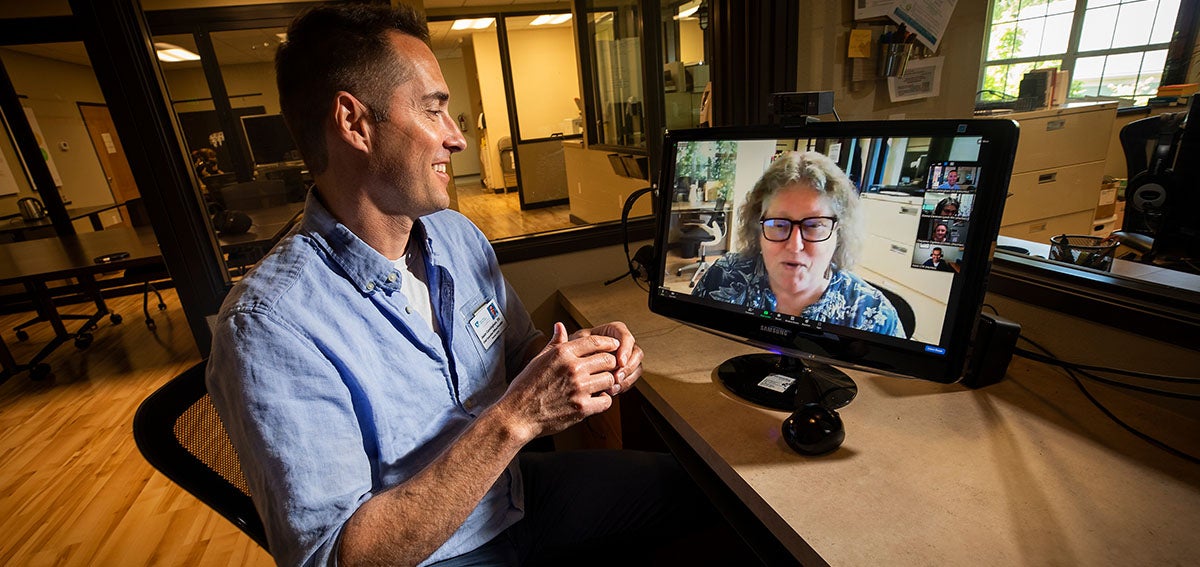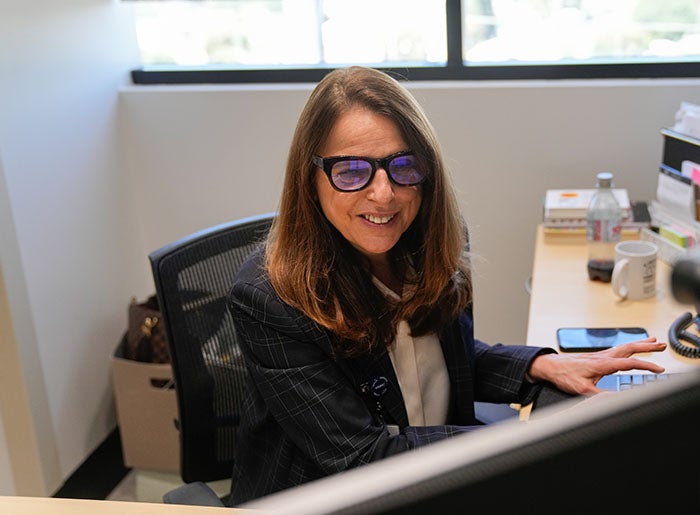
Clinic staff at Gravenstein Community Health Center greet patients one by one at the front desk, then direct them to assigned care team rooms. Doctors, nurses, and medical assistants go in and out of the various rooms attending to patients while 20 more are in the waiting room. It’s just a typical day at this health center in Sebastopol, a small city in Sonoma County wine country — except these patients didn’t have to walk into the clinic to see the staff. Each patient is sitting in front of a computer screen wherever it is convenient for them.
This is a virtual care clinic — a care model implemented by California health care organizations using real-time video technology to provide accessible, quality care.
“People go in and out of the rooms freely, without asking. That’s the magic of it,” said the doctor behind this clinic’s care model, Jason Cunningham, DO, the CEO of West County Health Centers. His organization is a Federally Qualified Health Center that operates Gravenstein and two other primary care sites as well as mental health services in western Sonoma County.
West County Health was one of 45 safety-net health care providers in California that received funding in 2020 to participate in a program to rapidly expand telehealth capacity among community health centers and to explore new ways to operate virtual care services. The 12-month program was established by the Connected Care Accelerator after the COVID-19 pandemic drastically restricted in-person medical visits. The program, run by the Center for Care Innovations and funded primarily by the California Health Care Foundation, tasked the health centers with finding and implementing solutions to serve patients remotely with quality, compassionate, and accessible care.
Profound Transformation
This was not a small undertaking. The health centers implemented models that were tailored to the unique needs of patients in a broad range of communities and were based on their particular staffing, technology, and infrastructure characteristics. Despite such challenges as language barriers, uneven digital access, and the difficult workflow changes, monthly telehealth visits for primary care increased from 2% of visits before the pandemic to 61% during the pandemic, according to an evaluation of 23 health centers (PDF). Most of those visits were conducted by telephone. The growth was even more impressive within the subset of behavioral health services, with telehealth accounting for 84% of visits.
The adoption of video visits took more time and varied significantly across health centers. While the Zoom platform is not new, an entire clinic using virtual exam rooms and back offices represents a profound transformation that took time for patients and providers to adapt to. Choosing a video platform was not easy. There were snags in preparing patients to use video visits and in determining how clinic staff should arrange for interpreters to join the conversations when necessary. Not all of them could achieve high use of video visits, research showed. But some did, including West County Health Centers.
“Leadership matters,” said Cunningham. “There has to be buy-in, and you have to talk about the why.” The goal of the virtual clinic was to mirror in-person visits, he said.
“At first, it can be intimidating for both providers and patients,” he said. “But soon it was no longer an option not to use video, and you can’t assume that patients can’t do Zoom.”
By June 2020, telehealth visits at West County Health grew from 10% to 50% of all visits, with more than half of telehealth encounters being video visits. The biggest increase was seen among mental health patients. “For people with anxiety, depression, and other psychiatric conditions, it is not easy to go out and see a provider,” Cunningham said. “This helped a lot.”
Reduced No-Shows
Patient no-shows went down, while mental health visits went up. “Right-size care at the right time,” he said. Access to behavioral health providers and other specialists was facilitated by providers using a shared phone number and Zoom extension to participate, he said.
West County Health serves a high percentage of patients with low incomes who are living in rural areas, many of them with transportation issues and with limited or no access to broadband. The system developed key community partnerships to provide points of computer access in libraries, fire stations, schools, and other sites to make Wi-Fi connectivity available to those without access to the internet in their homes.

For Grace Floutsis, MD, CEO and chief medical officer of White Memorial Community Health Center (WMCHC) in Los Angeles, the initial pandemic challenge was to figure out how to continue to provide quality care. Located in Boyle Heights, WMCHC delivers comprehensive primary care to a low-income community where 95% of patients are Latino/x, and 35% speak only Spanish. A lot of clinics had few in-person patient visits, she said. “But we had so many children and pregnant women in need of care that we couldn’t send the doctors home, so we stayed here.”
During the first three months of the pandemic, most patients used the phone, although many didn’t have unlimited data and had to pay extra for the time. The use of video increased when the clinic chose a video application integrating telemedicine and electronic medical records. It was the right software for a clinic designed as a patient-centered medical home. “We had to provide a lot of one-on-one training, and the workflow kept changing,” said Floutsis.
Does telehealth exacerbate health inequalities? “Not if done right,” Floutsis said. “It actually helps reduce health disparities if we offer telehealth and in-person — it has to be both.”
Telehealth Triage
WMCHC serves about 14,000 children. In the past, many would come in person for a cough or a fever. Now, with telehealth, the clinic first talks with patients on a video hookup to determine if they need to come in. “We realized that a lot of the episodic care we were providing as a walk-in could be provided as a same-day telehealth visit with just as good an outcome,” she said. “That was huge same-day access. That’s equity.”
Language was never a problem because the entire staff at WMCHC is bilingual, but at other clinics telehealth has significantly increased the need for medical interpreters. But Floutsis says patient access to broadband remains a challenge.
The switch from White Memorial’s walk-in clinic to this model required behavior changes that took patients some time to adapt to. Once that occurred, everybody saw the benefits, according to a patient survey, Floutsis said.
Alba Castro, a West County Health patient with multiple chronic conditions, says video has been a lifesaver. Cunningham is her primary care provider, and she sees 10 different specialists at UCSF. She must check with them constantly to manage her health problems. Her rheumatoid arthritis makes it difficult to get started every morning. First, she needs to be able to maneuver herself into a sitting position and do some exercises before being able to get up. Many times, she couldn’t make it to the doctor. Now, if she can’t get out of bed, she can still show up for her appointment online and maintain access to all her doctors.
Things are not so easy for Alba’s mother, who was born in Mexico and hasn’t seen a provider since the pandemic. Alba and her sister have taught their mother to use Zoom, but language is also a struggle. If her daughters can’t go to the appointment with her, she can’t see a doctor even if there’s an interpreter. “The communication is sketchy,” said Alba. “If she is not with the doctor in person, nothing that she’s told really registers.”
Next Step: An Evidence-Based Model of Care
While virtual care has improved access across patient populations, including patients from groups of diverse cultural backgrounds, educational attainment, and socioeconomic status, many people are concerned that telehealth leaves behind older adults, putting them at risk of losing access to critical medical care.
“I think all health centers should have offered some classes to teach people how to use Zoom,” Alba said. “Getting an appointment in person can take three months. With Zoom it is much faster.”
Telehealth has come a long way, but more needs to be done to help overcome the barriers that some patients still face. The next step is to turn the telehealth practice from a pandemic crisis response into an evidence-based model of care.
Like Cunningham and so many other California providers, Floutsis said she has witnessed telehealth improve the management of chronic disease, facilitate coordination of care, and result in better health outcomes.
“We know we are on the right track,” she said. “There are a lot of recommended practices but not a body of evidence suggesting that one way is better than the other, and we need that to happen. We are gathering data, but someone has to put it together and see what the information shows.”
Authors & Contributors

Silvina Martinez
Silvina Martinez is a public relations consultant specializing in health care and multicultural communications. A former newspaper reporter in Latin America and California and a medical interpreter herself, she works on health care initiatives and policies designed to expand access to care as well as educate and empower patients to take control of their health.

John Burgess
John Burgess has been a photojournalist at the Pulitzer Prize–winning Press Democrat and Sonoma Magazine for 31 years. On weekends he photographed over 350 assignments for Sports Illustrated, specializing in portraits of athletes like Barry Bonds, Tiger Woods, Buster Posey, and Jerry Rice.

Harrison Hill
Harrison Hill is a documentary photographer and filmmaker based in Los Angeles, California. His work focuses on social justice issues centered around communities of color in the US.



